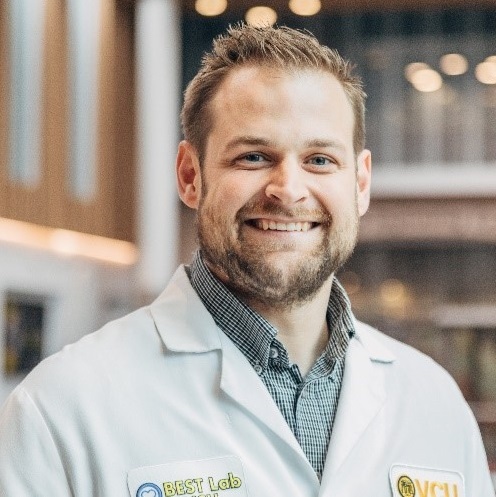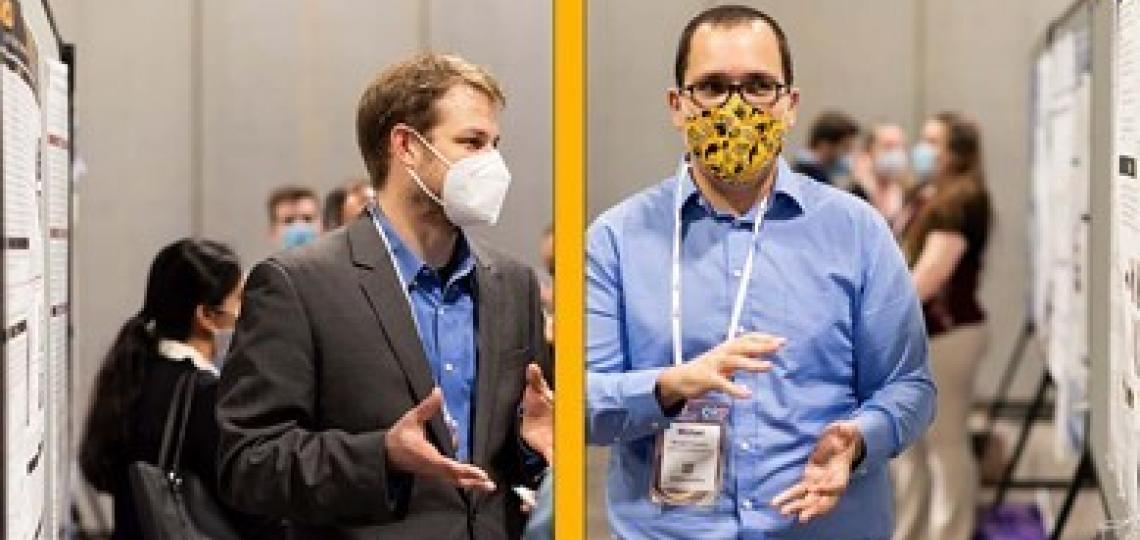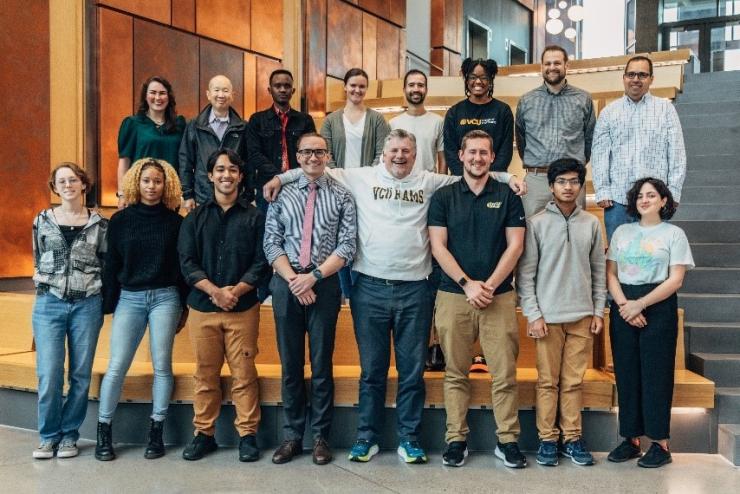TRISH Postdoctoral Fellowship is Advancing Space Health Research and Careers

Dr. Evan Buettmann
TRISH Postdoctoral Fellow
Virginia Commonwealth University
I looked anxiously at my empty apartment in St. Louis, MO, where I had spent the last 6 years completing my Ph.D. on bone regeneration. I was about to take a small respite with family before embarking on a new adventure to Richmond as a postdoc in Dr. Henry Donahue's Lab at Virginia Commonwealth University - College of Engineering. That’s when that familiar email notification on my phone went off and I saw the header, “TRISH fellowship application in space health” from Dr. Donahue.
I thought to myself, “What is TRISH and how could my research interests in bone biology relate to space health?”
I knew Dr. Donahue’s Bone Engineering Science Technology (BEST) Lab was actively looking at how to combat spaceflight hazards’ effects on the musculoskeletal system and this was one of the pulls for joining his lab. However, I was unsure what a TRISH fellowship was and how it could relate to my research career. Therefore, I did what any freshly minted Ph.D. would do… I tried to keep an open mind and began to research more about how TRISH (Translational Research Institute for Space Health), NASA (National Aeronautics and Space Administration), and the ways my past and present research interests in bone healing could apply to space health.
I learned through my research that TRISH was interested in funding cutting-edge and high-risk/high-reward research proposals to promising postdoctoral scientists in their fellowship solicitation. In particular, any research plan that would provide additional countermeasures or in-flight biomarker data collection and monitoring related to one or more of the NASA Human Research Program (HRP) gaps/risks would be accepted.
I was thrilled to see that one of the research gaps was related to better understanding how spaceflight affects fracture healing and it was still open (unmitigated) on NASA’s HRP page. The BEST lab group had recently published that Connexin 43 (Cx43; a major gap junction communication protein) deletion in bone cells attenuates simulated microgravity-induced bone loss, and I thought, “Well what about Cx43’s role in bone healing during spaceflight?” I immediately began putting together my proposal, with assistance from Dr. Donahue and Dr. Michael Friedman, another TRISH fellow in the BEST Lab.
The TRISH application was unlike any other grant application I had completed in the past - but in a good way. To me, my TRISH proposal represented a unique opportunity for me to fully integrate my interdisciplinary background in biomedical engineering, biomechanics, and molecular biology. More importantly, it allowed me to pursue a research agenda related to but independent of my mentor’s, which is crucial when trying to transition to independence following a postdoc. Finally, it allowed me to help solve pressing needs for extraterrestrial exploration, which also had important ramifications for current terrestrial health practices. Plus, space is cool, and I’m a huge sci-fi nerd. Need I say more?
My advice to anyone thinking about or planning to apply for a TRISH postdoctoral fellowship is to start early, identify a solid mentor with ample resources to support your professional growth and independent research endeavors. My research wouldn’t be possible without Dr. Donahue’s support and guidance and I’m very thankful to have the BEST mentor for my project. In addition, use the TRISH research proposal to also further your scientific training along the way. After all, TRISH wants to fund and support the next generation of space health scientists, a field that will only expand and become increasingly important with the privatization of spaceflight. My recipe for success was to find a space health question you’re passionate about (even if you don’t know everything about the topic), make it a priority to learn multiple new techniques along the way (scRNA-seq; spatial transcriptomics, organ-on-a-chip, biomarker development, etc.) and collaborate with new scientists outside your immediate discipline.
Your TRISH proposal doesn’t have to be perfect on the first try, since space health research may be a new area of exploration for many scientists, as it was for me. Regardless of your proposal’s score, you’ll have the opportunity to receive written in-depth feedback from three reviewers, and if necessary resubmit during the next cycle. For example, I was glad that I applied early during my postdoc, for it was only after I addressed key reviewer concerns and altered my experimental design substantially, that my proposal was finally selected upon resubmission.
Finally, it’s important to note that the fellowship is only two years (follow-on funding from TRISH for a 3rd year requires an additional application and available funds), which goes very quick. Therefore, it’s often ideal to work with a mentor that already has spaceflight specimens collected or has capabilities to help you use ground-based spaceflight analogs. As someone who has only been a TRISH postdoctoral fellow throughout the COVID-19 pandemic, I can say that unexpected events can happen. Always have room to pivot. You don’t want your whole fellowship project to be dependent on a successful spaceflight launch, which are often delayed or scrubbed due to unforeseen conditions.
I would never have thought that I would be supported by TRISH during my postdoctoral training, but I am so glad that I applied and was selected. My long-term career goal is to become an independent investigator dedicated to musculoskeletal and space health research and education. I will utilize the latest in vivo, in vitro, and computational models of mechanical loading and disuse with transgenic models to decipher the cells, genes, and molecular pathways involved in the mechanobiology of fracture healing and osteoimmunological crosstalk during regeneration.
I will continue to be a strong advocate for space health and orthopaedic research in our community by presenting my research findings at international society meetings and by teaching and mentoring the next generation of musculoskeletal and space health scientists. This opportunity with TRISH has significantly aided in these ventures by expanding my research portfolio, allowing me to make new connections, and become a more well-rounded scientist.
TRISH has significantly aided in these ventures by expanding my research portfolio, allowing me to make new connections, and become a more well-rounded scientist.
Only through this proposal was I afforded the opportunity to study bone fractures in simulated microgravity (my mentor had no active projects in this area). With TRISH’s support, I’m now using a preclinical model system to now test how novel therapies (drugs, exercise, genetic engineering) can improve bone mass and healing during disuse that would have applications to spaceflight, aging, and extended bed rest. My initial findings have been promising, and I’m now expanding into looking at immunological and skeletal muscle effects on bone healing and noninvasive virtual biomechanics testing with new collaborators Drs. Rene Olivares -Navarrete (VCU), Hannah Dailey (Lehigh), and Megan Killian (UMich). This expansion of my initial research interests will allow me to carve out a niche for my own lab, allow me to also investigate additional knowledge gaps in the space health field and stay competitive for future solicitations.
This fellowship isn’t just about the research and deliverables, TRISH is also heavily invested in the professional development of its postdoctoral research fellows. As a TRISH postdoc, I’ve been a part of monthly calls with TRISH/Baylor College of Medicine staff in the Academy of Bioastronautics (AoB) and annual NASA Investigator Workshop Series (IWS) meetings. These AoB meetings have given me opportunities for additional networking and professional development. Through these meetings, I’ve met new potential collaborators in the musculoskeletal space such as Dr. Jeffrey Willey (Wake Forest University), learned about resources available to me (NASA Gene Lab), improved science communication, built an effective CV and learned how to apply for research positions across the career spectrum. I also can’t wait to finally meet my fellow postdocs at the annual IWS meeting in Galveston this upcoming year (our first in-person meeting since I’ve become a TRISH fellow). Many previous TRISH researchers have said that although it won’t guarantee an independent science position, having funding from TRISH/NASA on your CV and the words space health will definitely get your application some “extra-attention”.
In closing, I highly recommend applying for the TRISH postdoctoral fellowship and the opportunities it will afford any emerging independent scientist. Whether your long-term career plans are in industry, government, nonprofit, or academia, TRISH will greatly expand your network and research skills into new, exciting avenues and connect you with experts in these respective professional areas for jobs and mentoring. The frontier of space and all its mysteries and challenges offer little respite for the human condition. Space health problems have only begun to be realized as we envision longer and further destinations from Earth. Only by engaging an emerging group of scientists, as TRISH is doing with its postdoctoral program, will we be able to overcome these limitations and challenges together. I’m happy to talk to anyone about TRISH, space health, and musculoskeletal research online @Evan Buettmann. There’s a lot of exciting space health research advances coming out from the BEST Lab (@BESTLABVCU; http://bestlabvcu.org/) and my colleague and fellow TRISH orbiteer Dr. Michael Friedman (@MAFriedmanVCU), so be sure to follow everyone online.
TRISH is currently seeking new postdoctoral fellows who are eager to solve the health challenges of human space flight. The deadline to apply is Jan. 26, 2023.








 Credit
Credit

